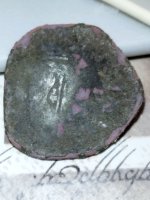- Feb 2, 2013
- 1,463
- 2,063
- Detector(s) used
- Many
- Primary Interest:
- All Treasure Hunting
Queen Tin Hinan is renowned in Tuareg history as a fourth century matriarch of great prestige – named “Mother of Us All”. Her monumental tomb was located in 1925 in the Sahara desert, but dramatic archaeological discoveries of the day, such as King Tut’s tomb, somewhat overshadowed her unveiling...
For some, the 1920s were an exciting time to be alive. The Great War had just ended in 1918, and some countries were enjoying economic boom, allowing their citizens to indulge in lavish and decadent lifestyles. In the field of archaeology, sensational discoveries were being made, including the find of Tutaankhamun’s tomb by Howard Carter, and the excavation of the city of Ur by Leonard Woolley, both in 1922.
When the ‘tomb of Tin Hinan’ was found and opened by Byron Khun de Prorok and the French Army in 1925, the discovery received much less publicity than other ancient finds. This may have been as Prorok was considered the “original tomb raider” of his time, and not well respected by the scientific community.
In 1920s, Byron Khun De Prorok was director of archeological excavations in Carthage.
‘Count’ Byron Khun de Prorok was a Polish-American amateur archaeologist who was interested in ancient legends. With the support of the French, who were the colonial masters of much of West Africa, de Prorok was able to launch an expedition into the Saharan desert. At Abalessa in the Hoggar region of southern Algeria, de Prorok discovered a monumental tomb. This circular structure, which was located on a hill overlooking a dried river bed, or wadi, was made of stone. It had a height of almost 4 meters (13 feet) and a diameter of almost 23 meters (75 feet). According to local tradition, this was the tomb of Tin Hinan.
Tin Hinan, whose name literally means “she of the tents”, is regarded as the ancient ancestress of the Tuaregs. According to local legends, centuries ago Tin Hinan arrived in the Hoggar region on a milk-white camel along with her faithful servant, Takamet. They are said to have settled in the mountainous region of Algeria, and she became the first Queen of the Tuaregs.
Tuaregs are Berber nomadic people of the Sahara. In the 20 th century they were referred to as “People of the Veil” or even “the Blue People,” in a description of their brightly indigo-colored clothing.
The warrior caste of the Tuaregs believed that they were Tin Hinan’s direct descendants, while the peasantry regarded themselves as the offspring of her handmaiden Takamet.
In 1925, de Prorok was unlikely to have any qualms about opening the tomb, though the Tuaregs viewed this as an act of desecration. A thunderstorm that broke out suddenly during the expedition gave fuel to the superstition that angry djinns (supernatural creatures made of smokeless fire) were avenging the desecration of Tin Hinan’s tomb. The storm soon passed, however, and de Prorok continued his work.
The tomb contained a number of rooms, though it had only one entrance. Based on its plans, it has been suggested that it was originally a Roman fort. Some have even linked this structure with the Roman raid into the Sahara under Lucius Cornelius Balbus in 19 B.C. When the Romans left the area, the fort may have been re-used by the locals, eventually becoming a tomb.
In the southwestern corner of the tomb, de Prorok and his team came upon the first room. Within this room was a grave beneath nine irregular slabs of stone. When these were removed, de Prorok found the skeleton of a woman with her legs crossed, and head tilted slightly to one side. The deceased once laid on a wooden platform, and was covered by a red leather cloak, though this had long crumbled into dust. The right arm of the woman was adorned with seven heavy silver bracelets, while her left had seven gold ones.
Other jewelry, including beads of turquoise, garnet, amazonite and cornelian, were also found in the tomb. It has been suggested that these prestige items came from Carthage in the north. The dating of the tomb, however, was made possible by analyzing the pottery located among the artifacts.
When the wooden platform was carbon dated years later, the results suggest the woman was buried there sometime between the third and fifth century, which agreed with the dates gained through the analysis of pottery typology.
The wealth of objects in the grave indicates that the woman buried there was almost certainly someone of high status in her society. Yet, apart from local tradition, some argue that there is nothing else to prove that the skeleton belonged to Tin Hinan. Regardless of the woman’s identity, this would probably not affect the respect that the Tuaregs hold for their great ancestress.
One of the ways Tin Hinan is honored today is the celebration of the Tin Hinan Festival, a tribute not only to this queen, but also to the role that women play in Algerian society today. https://www.ancient-origins.net/his...n-tin-hinan-ancient-ancestress-tuaregs-002833
For some, the 1920s were an exciting time to be alive. The Great War had just ended in 1918, and some countries were enjoying economic boom, allowing their citizens to indulge in lavish and decadent lifestyles. In the field of archaeology, sensational discoveries were being made, including the find of Tutaankhamun’s tomb by Howard Carter, and the excavation of the city of Ur by Leonard Woolley, both in 1922.
When the ‘tomb of Tin Hinan’ was found and opened by Byron Khun de Prorok and the French Army in 1925, the discovery received much less publicity than other ancient finds. This may have been as Prorok was considered the “original tomb raider” of his time, and not well respected by the scientific community.
In 1920s, Byron Khun De Prorok was director of archeological excavations in Carthage.
‘Count’ Byron Khun de Prorok was a Polish-American amateur archaeologist who was interested in ancient legends. With the support of the French, who were the colonial masters of much of West Africa, de Prorok was able to launch an expedition into the Saharan desert. At Abalessa in the Hoggar region of southern Algeria, de Prorok discovered a monumental tomb. This circular structure, which was located on a hill overlooking a dried river bed, or wadi, was made of stone. It had a height of almost 4 meters (13 feet) and a diameter of almost 23 meters (75 feet). According to local tradition, this was the tomb of Tin Hinan.
Tin Hinan, whose name literally means “she of the tents”, is regarded as the ancient ancestress of the Tuaregs. According to local legends, centuries ago Tin Hinan arrived in the Hoggar region on a milk-white camel along with her faithful servant, Takamet. They are said to have settled in the mountainous region of Algeria, and she became the first Queen of the Tuaregs.
Tuaregs are Berber nomadic people of the Sahara. In the 20 th century they were referred to as “People of the Veil” or even “the Blue People,” in a description of their brightly indigo-colored clothing.
The warrior caste of the Tuaregs believed that they were Tin Hinan’s direct descendants, while the peasantry regarded themselves as the offspring of her handmaiden Takamet.
In 1925, de Prorok was unlikely to have any qualms about opening the tomb, though the Tuaregs viewed this as an act of desecration. A thunderstorm that broke out suddenly during the expedition gave fuel to the superstition that angry djinns (supernatural creatures made of smokeless fire) were avenging the desecration of Tin Hinan’s tomb. The storm soon passed, however, and de Prorok continued his work.
The tomb contained a number of rooms, though it had only one entrance. Based on its plans, it has been suggested that it was originally a Roman fort. Some have even linked this structure with the Roman raid into the Sahara under Lucius Cornelius Balbus in 19 B.C. When the Romans left the area, the fort may have been re-used by the locals, eventually becoming a tomb.
In the southwestern corner of the tomb, de Prorok and his team came upon the first room. Within this room was a grave beneath nine irregular slabs of stone. When these were removed, de Prorok found the skeleton of a woman with her legs crossed, and head tilted slightly to one side. The deceased once laid on a wooden platform, and was covered by a red leather cloak, though this had long crumbled into dust. The right arm of the woman was adorned with seven heavy silver bracelets, while her left had seven gold ones.
Other jewelry, including beads of turquoise, garnet, amazonite and cornelian, were also found in the tomb. It has been suggested that these prestige items came from Carthage in the north. The dating of the tomb, however, was made possible by analyzing the pottery located among the artifacts.
When the wooden platform was carbon dated years later, the results suggest the woman was buried there sometime between the third and fifth century, which agreed with the dates gained through the analysis of pottery typology.
The wealth of objects in the grave indicates that the woman buried there was almost certainly someone of high status in her society. Yet, apart from local tradition, some argue that there is nothing else to prove that the skeleton belonged to Tin Hinan. Regardless of the woman’s identity, this would probably not affect the respect that the Tuaregs hold for their great ancestress.
One of the ways Tin Hinan is honored today is the celebration of the Tin Hinan Festival, a tribute not only to this queen, but also to the role that women play in Algerian society today. https://www.ancient-origins.net/his...n-tin-hinan-ancient-ancestress-tuaregs-002833






